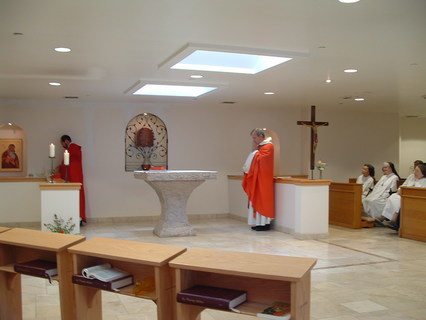Ecce quam bonum et quam jucundum

What do these Catholic bloggers do when they meet? Pray. Sing. Talk. Eat. Pray. Sing. Talk. Eat. Did I mention the singing? This photo of Father Jeffrey Keyes, C.PP.S. of Rifugio San Gaspare, Richard Chonak of Catholic Light, and myself was taken in the entrance garden of the little church of the Monastery of the Glorious Cross, O.S.B. in Branford, Connecticut.

Yesterday we sang the beautiful Ordinary XII (Pater cuncta), together with the Introit Salus autem and the Alleluia Te martyrum from the Mass of SS. Pontian and Hippolytus. Mass at the Monastery of the Glorious Cross is at 11:50 on weekdays and at 11:00 on Sundays and Solemnities. When I am not serving as chaplain the times of Mass may vary, so ring ahead.
The monastery church had to be designed in an existing space. The building is the former Connecticut Hospice. The low ceiling posed real problems. We opened it up with two light wells: one directly over the altar, and another directly over the place where Holy Communion is distributed. The low walls surrounding the sanctuary were another challenge. They contain all sorts of pipes and wiring and could not be removed. We integrated them into the design to form a very effective delineation of the the sanctuary. The Benedictine nuns are in two choirs to the right and left of the sanctuary. The lay faithful have chairs and kneelers facing the sanctuary.
The crucifix came from the workshops of the Nuns of Bethlehem and of the Assumption. The icons of the Saviour and of the Mother of God are by a Benedictine of Jesus Crucified in France.
We are presently holding a Novena of Masses for the happy repose of the souls of all those who died in the monastery building while it was The Connecticut Hospice.

Yes, I do celebrate Holy Mass ad orientem. The wrought iron gates in front of the tabernacle are closed during the Holy Sacrifice and remain open outside of Mass. The conical chasuble of red wool is the work of Vincent Crosby. He explains the conical form of the chasuble:
The chasuble originated in the everyday dress of the Roman citizen at the beginning of the Christian era. It was known as the paenula, the outer garment that entirely enveloped the figure and hung in radiating folds. It had a cone-like or conical shape. To free the hands it was necessary to gather up the material into graceful folds across the forearms. Over the centuries the shape of the chasuble has altered, reflecting changes in liturgical theology and presidential style. But the classic form of the conical chasuble remains the authentic shape of the Eucharistic vestment. For the artist, it is a more interesting garment to design because unlike the more static “gothic” chasuble, the conical chasuble changes as it responds to the human body. It is also a more rewarding garment to wear because of the beauty of its folds.

Reverend and dear Father:
I have so enjoyed your blog site since discovering it a week or two ago. May the Lord continue to guide and support you in this Cyber World outreach. As to the Conical Chasuble; my Liturgical mentor, when a seminary student and young Priest, wore exclusively the Conical form of the Chasuble. At my Ordination to the Priesthood 19 years ago, he made me a beautiful set which I use as often as I can. It certainly bring inquires from both the Faithful and Religious.
Dear Father Yohannes,
Thank you for your kind comment. I woud be delighted to hear from you again. It is always a grace for me when a brother priest finds Vultus Christi helpful.